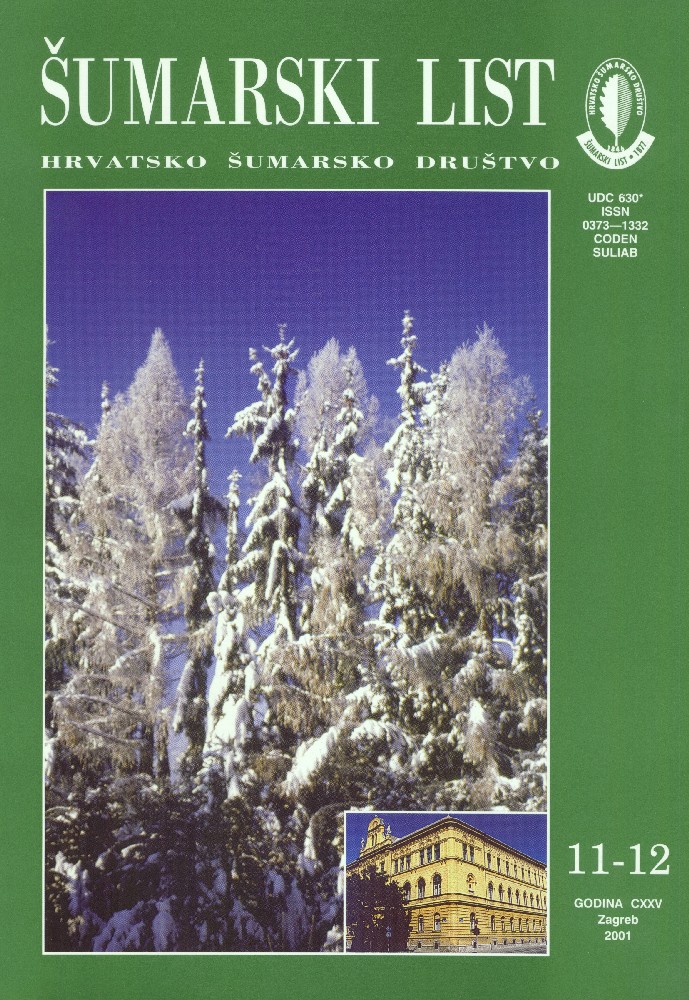| Matić, S., Rauš, Đ., Seletković, Z., Španjol, Ž., Anić, I., Oršanić, M., Tikvić, L., Baričević, D. | UDK 630* 189 + 269 + 41 : 907.1 (001) |
Summary: The paper analyses the damage of plant species in open strips by moufflon (Ovis ammon musimon Pal.) and axis deer (Axis axis Erx.). The research was done in an enclosed part of the State Hunting Ground VIII/6 “Kalifront” covering an area of 1351.22 ha. The hunting ground is located on the island of Rab. Since virtually the entire area of the hunting ground is situated on the peninsula, the central part was fenced off with a barrier (in the length of 3.4 km). In the enclosed part of the hunting ground, there were a total of 45 moufflon species and 22 of axis deer in the course of research. Taken as a whole, the density of all big game population came to 8 heads per 100 ha in the total hunting area (Table 1). The reconstruction of the hunting ground has thoroughly changed the participation of the land per categories. Of a total of 840 ha of the enclosed area, forests account for about 825 ha (98 %), while paths (8.8 ha), open strips (5.9 ha) and grassland – the Topolje nursery and the A. Petračić nursery (1.5 ha) – account for the remaining 15 ha. It was for this reason that forage crop areas had to be established to feed the game in the hunting ground, because it was estimated that the game would not be able to satisfy their nutritional needs exclusively in the forest areas. The research was done on the 13th, 14th, 15th and 16th October 1999. The preferability of the game-damaged plants was calculated using the Preference ratio index (Pi).In the experimental plots with open strips a total of 190,700 plants/ha were recorded. The most abundant was Rubus dalmaticus with as many as 20,600 plants/ha. This species also had the highest frequency (87 %). It is followed by Daucus major with 14,800 individuals/ha (f = 52 %) and Picris hieracioides with 11,900 individuals/has (f = 38 %). The following woody species were recorded: Rubus dalmaticus, Viburnum tinus (3,500 individuals/ha), Erica arborea (3,400 individuals/ha), Fraxinus ornus (1,400 individuals/ha), Myrtus communis (1,200 individuals/ha), Clematis flammula (1,100 individuals/ha), Spartium junceum (1,300 individuals/ha), Coronilla emeroides (1,000 individuals/ha), Cistus salviefolius (800 individuals/ha), Arbutus unedo (700 individuals/ha), Pinus pinaster (700 individuals/ha), Cistus villosus (600 individuals/ha), Ligustrum vulgare (400 individuals/ha), Prunus domesticus (400 individuals/ha), Quercus ilex (400 individuals/ha), Clematis vitalba (300 individuals/ha), Crataegus transalpina (200 individuals/ha) and Phillyrea latifolia (100 individuals/ha). Together with Rubus dalmaticus, these make up 19 woody species (Figure 1). A total of 70 plant species were registered in the open strips (Table 1). The game made use of 35 of them for their feed (50 %). In terms of the number of species and forms in the experimental plots, there were 53 % of herbaceous plants, 27 % of woody plants and 20 % of grasses and sedges. However, in terms of the proportion of the species within the consumed species, the ratio is somewhat different. Herbaceous plants account for 60 %, woody plants for 29 % and grasses and sedges for 11 % (Figure 2). With regard to the ratio of consumed and non-consumed species in the categories of herbaceous plants, grasses and sedges and woody plants, the situation is as follows: of a total of 37 herbaceous plants, 21 are consumed by the game (57 %), of 19 woody plant species, 10 (53 %) are used by game, while of 14 kinds of grasses only 4 (29 %) are consumed. The most preferred species (Table 3) was Raphanus raphanistrum – Pi = 4.24, followed by Picris hieracioides – Pi = 3.99, Senecio erraticus – Pi = 3.84, Verbena officinalis – Pi = 3.78, and Daucus major – Pi = 3.54. The most preferred woody species was Coronilla emeroides, which took the sixth place (Pi = 3.39), while among the grasses, the most preferred was Holcus lanatus, taking the 25th place (Pi = 0.71). The importance of open strips, that is, their maintenance in the Mediterranean area is highly significant not only as a source of game food, but also as a defence against possible fires. The maintenance of open strips is gaining increasing importance from the standpoint of hunting economy, because their mowing provides relatively good quality pasture. Thus, it is not necessary to clear and cover forest areas with grass in order to ensure sufficient forage for the game. All consumed plants in the sample had poor nutritional value, which ranged from poor to very harmful (for example, Senecio erraticus). It is important to point out that oculary inspection of the faeces in the hunting ground did not reveal any digestive disorders, which means that the game uses the depressive, harmful and very poisonous plants in the optimal manner. Accordingly, game is a more economic consumer of the neglected area than domestic animals. In order words, in terms of using natural nutritive resources, game converts plants into meat, trophies, hide etc, more economically, and therefore, not much investment is required to improve the sites.
Key words: grasses; herbaceous plants; moufflon (Ovis ammon musimon Pal.) axis deer (Axis axis Erx.); open strips; openings; pasture; preferability; preference ratio index; woody plants |



